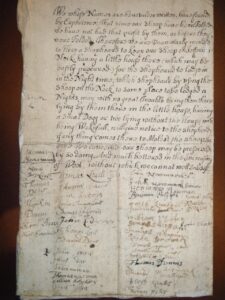History came vividly alive for me on a cold December day ten years ago in Salem, Massachusetts. For a retired historian, the Phillips Library of Salem’s Peabody Essex Museum was the perfect place to enjoy a brief respite from winter’s doldrums by indulging in the quiet pleasures of archival research. Housed in an elegant, mid-nineteenth-century Italianate townhouse brimming with antiques and historical artifacts, the library’s reading room was warm, intimate, and inviting – its library tables and comfortable Windsor chairs surrounded by bookshelf walls filled with classic reference works on New England history. Above them, original portraits and busts of prominent Massachusetts Bay colonists gazed down on the reading room’s patrons – who, on the day in question, consisted of a few family history gray-beards like myself and a young doctoral candidate or two engaged in dissertation research.[1]
I had a table to myself in a far corner of the room, where I’d been immersed for several hours in the original seventeenth-century manuscript records of the Essex County Quarterly Courts, looking for references to my great-great-great-great-great-great-great-grandfather John Grow (ca. 1642-1727), an obscure Ipswich, Massachusetts, weaver and the presumed progenitor of the Grow family in America.[2] I had almost finished leafing through a folder of documents from a 1680s court case when I suddenly came upon a one-page hand-written petition submitted to the Ipswich selectmen in April 1686 by forty local commoners asking the town government to hire a shepherd for the community's Jeffrey's Neck sheep commons to safeguard the sheep pastured there from attacks by wolves and other predators.[3]
One of the petitioners was John Grow. He had signed the petition with his “mark”: a scraggly, uneven capital “I” with a horizontal crossbar through the middle of the upright – the standard form for the letter “J” in seventeenth-century English writing, and in this case short for “John.” The instant I laid eyes on the mark, my mind began reeling from the realization that I had stumbled upon a remarkable family artifact: the crude “signature” that the probable founder of the Grow family in America – my direct ancestor nine generations removed – had put down on paper 326 years earlier as a resident of a Massachusetts Bay Puritan community.
The serendipitous discovery had an immediate and powerful impact on me, both intellectually and emotionally. It first of all confirmed what I had long suspected: that John Grow was illiterate. Signing the petition with a simple mark rather than a full signature was a strong indication that he could not write his own name – the basic test of literacy.[4] Literate colonists occasionally signed a deed or a will with a mark for the sake of convenience, a practice considered legally valid because the scribe who drafted the document had already recorded the signatory’s name on it and the signatory needed only to “initial” it with his mark in order to make it official. A petition, however, did not have the petitioner’s name recorded on it prior to being signed, and as a result a mark was of little value unless the petitioner was also identified by name. Consequently, illiterate petitioners, to legitimize their marks, customarily had a literate townsperson write their name for them next to their mark.[5] On the 1686 Ipswich petition, for example, John Grow’s mark is placed to the immediate left of the name “john grow” in cursive, which a literate fellow petitioner had likely written for him.
A petition, however, did not have the petitioner’s name recorded on it prior to being signed, and as a result a mark was of little value unless the petitioner was also identified by name.
The knowledge that my ancestor was illiterate helped me place him in a broader social context. It’s estimated that in the 1660s approximately forty percent of adult males in Essex County were unable to write their own names and that an overwhelming majority of those men belonged to the lower or lower-middle ranks of society.[6] As a result, John Grow’s use of a mark on the 1686 petition was a valuable piece of evidence that enabled me to expand the traditional description of him as an Ipswich weaver by identifying him in broader terms as an illiterate artisan in the bottom half of seventeenth-century Massachusetts Bay society.
The mark’s discovery also had a surprisingly profound effect on me emotionally. It was not, genealogically speaking, a particularly significant breakthrough – revealing nothing, for example, about John Grow’s origins. And yet, as I sat staring at it, studying its details at close range, there was something about the mark that spoke to me at a deeply personal level. The piece of paper on which it was written – the piece of paper that I was now holding in my hands – wasn’t a photocopy or a reproduction; it was the original copy of the 1686 petition, the actual piece of paper that my earliest-known ancestor in America had held in his hands more than three centuries earlier as he placed his mark on it. The mark itself, moreover, had a strangely expressive quality, a physical presence that seemed to communicate something tangible about the man who made it. Its unevenly drawn lines of varying thicknesses, the small dot of ink that had dripped onto the paper as John Grow transferred the quill pen in his hand from an inkwell to the petition’s surface – together, these visual details conveyed a tactile impression of a simple, uneducated manual worker for whom the physical act of handwriting was awkward and unnatural.
Like any historical artifact, John Grow’s mark was a material link to the past – in this case, a tangible link to a seventeenth-century ancestor whose DNA I shared. As I looked at the mark, touching it with my fingertips -- touching something that he had produced with his own hand – I felt a vague, almost indefinable sense of physical connection to the man who made it. It was as if by touching what he had touched I was experiencing a form of indirect personal contact with him across the three centuries and nine generations of family history that separated us. A small, nondescript mark on a long-forgotten document had brought history personally alive for me in a way that perhaps only passionately engaged family historians would fully understand.
Notes
[1] Sadly but understandably, the Phillips Library’s manuscript collections and reading room were moved to a modern, climate-controlled collections center in Rowley, Massachusetts, in 2017.
[2] Michael Grow, John Grow of Ipswich, Massachusetts and Some of His Descendants: A Middle-Class Family in Social and Economic Context from the 17th Century to the Present (Amherst, Mass.: Genealogy House, 2020), 9-36; Michael Grow, “John Grow of Ipswich, Massachusetts: An Update,” The New England Historical and Genealogical Register 167 [2013]: 199-203; George W. Davis, John Grow of Ipswich/John (Groo) Grow of Oxford (Washington, D.C.: privately printed by the Carnahan Press, 1913; repr. Salem, Mass.: Higginson Book Company, n.d.), 5-15.
[3] Petition to the Ipswich, Massachusetts, selectmen, 12 April 1686, “Records of the Essex County Quarterly Courts, 1636-1694,” Phillips Library, Peabody Essex Museum Collection Center, Rowley, Mass., box 46, folder 69. The petition is reproduced in Grow, John Grow of Ipswich, Massachusetts, Appendix B.
[4] It is possible, of course, that John Grow could read but not write. According to historian David D. Hall, in Worlds of Wonder, Days of Judgment: Popular Religion in Early New England (New York: Knopf, 1989), 32, “when defined as the skill of reading English, literacy was almost universal in Puritan New England,” largely “because reading had such a high importance in the religious system.” Puritanism placed great emphasis on the ability to read “the Word,” and as a result, Hall writes, even “ordinary people … were comfortably acquainted with the language of their Bibles.” “Wealth and occupation were significant in sorting out mere readers from those who learned to write as well: every minister in New England possessed both skills, as did merchants and magistrates. But in trades where writing did not play a major role” – such as weaving, John Grow’s livelihood – “people often stopped with learning how to read.”
[5] Alison I. Vannah, “‘Crochets of Division’: Ipswich in New England, 1633-1679” (Ph.D. dissertation: Brandeis University, 1999), 435-37.
[6] Kenneth Lockridge, Literacy in Colonial New England (New York: W. W. Norton, 1974), 22; Vannah, “‘Crochets of Division’: Ipswich in New England, 1633-1679,” 436; David Cressy, Coming Over: Migration and Communication between England and New England in the Seventeenth Century (Cambridge: Cambridge University Press, 1987), 217. During the same period, two-thirds of Essex County women were illiterate, according to Lockridge (p. 38).
Share this:

About Michael Grow
Michael Grow, a retired history professor at Ohio University and a longtime NEHGS member, is the author of John Grow of Ipswich, Massachusetts and Some of His Descendants: A Middle-Class Family in Social and Economic Context From the 17th Century to the Present (Amherst, Mass.: Genealogy House, 2020).View all posts by Michael Grow →

